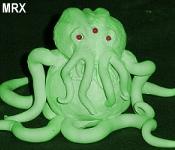Starting with the player pieces, the roads/tunnels have held up fine. I mean, what can really go wrong with some painted MDF strips, right? But the Altars and Temples have shown some deterioration. Some of the little Cthulhu figures have come unglued from their bases. Also, the polyurethane resin that was used to close off one end of the PVC rings has started to separate from the PVC. Apparently, the two did not bond well and if you are not careful, you can easily just pop them apart. I was never really thrilled with the way they came out in the first place. It was kind of a rush job. To do it over, I would not use PVC and urethane resin for these.
The carved polystyrene foam has weathered surprisingly well. There are a few places where the paint has begun to chip off, but it could be touched up very easily. Only one of the foam pieces shows any sign of damage, and that is a mountain peak who's tip got a little crushed in transport. If you didn't know you would probably never notice.
The one material that did not hold up as well as the others was the air dry clay known in crafting circles as cold porcelain. This was the first time I had ever used cold porcelain (a mixture of white glue and corn starch), and although I'm sure it has its uses, it also has its limitations. Most of the tiles that were made with the air dry clay show significant deterioration. Most of the problems seem to have been caused by the material continuing to shrink over time.
On the aforementioned Pits of Despair, there is some splitting along the sides of the craters, especially in the crevices where the clay was thin. You can now see some of the foil armature through the cracks. The crater walls still seem quite strong though, and there appears to be little to no breakage from wear. Also, the bottom edge of the crater, where it blends with the MDF tile base, has shrunk up and is separating from the MDF. They are still firmly attached to one another, but it is no longer a smooth transition from crater wall to ground. There is a definite fault line around the base of the crater. It is quite noticeable, but if you had never seen the tile before, you might think that it was supposed to be that way. It doesn't really ruin the effect, it just doesn't look as good.
There is some separating around the bases of the monoliths of the Cyclopean Ruins, as well. The monoliths themselves are fine, but where they blend into the MDF base, the air dry clay has shrunk and separated creating a visible fault line, just like around the craters of the Pits of Despair.
The tiles that show the most damage are the Ravenous Caverns. They each show the same signs of separation where the Clay blends into the MDF base, as the rest of the tiles. And they also show the same splitting over the foil armature that the Pits of Despair show. But the Caverns also show significant damage around the mouths of the caverns. The thin stalactites hanging from the cave roof have mostly broken off. Some of the outer rim of the cave mouth has cracked and broken off too. It appears that the clay used in this area was too thin, and also, the plastic cup used as the armature is too flexible. I should have made the mouth of the caves a little beefier. They were just too thin and delicate.
So there you have it. If you are planning on using any of these materials or techniques for your own projects, now you can get a glimpse as to how they will wear over time. My best advise would be to account for significant shrinkage of the air dry clay over time.
See also:
Cultists of R'lyeh pt.1- the Desolate Waste
Cultists of R'lyeh pt.2- the Pits of Despair
Cultists of R'lyeh pt.3- the Ravenous Cavern
Cultists of R'lyeh pt.4- the Cyclopean Ruins
Cultists of R'lyeh pt.5- the Sanguine Gorge
Cultists of R'lyeh pt.6- the Mountains of Madness
Cultists of R'lyeh pt.7- the Game Pieces, Portals, et Fini
































Ah, posts like that are really helpful. Most tutorials don't bother coming back to a project to show the effects of wear an tear.
ReplyDeleteGreat!